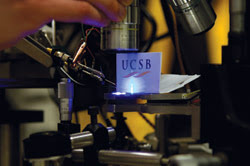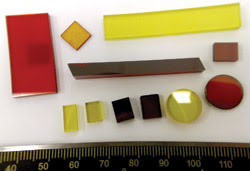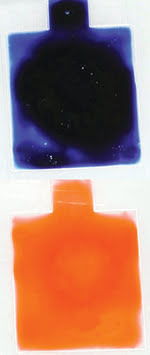Despite the economic downturn, laser diodes keep on pumping – sometimes literally. They often provide the pump for fiber lasers, a market segment that is still relatively strong. However, laser diodes are more than just sidekicks. They also are very useful on their own and in other settings.
No matter the application, there has been some encouraging news lately for laser diodes. For one thing, costs look to be declining. For another, advances involving semiconductor materials promise new types of laser diodes. Other innovations look as if they might lead to a plastic version of the devices. A look at these and other developments reveals some of the trends in laser diodes.
Putting out power
As with light-emitting diodes, laser diodes consist of complementary semiconductor materials that convert electricity into light. Injecting the appropriate current into the device at the right voltage results in lasing, with a material-dependent emission wavelength.
Given that, the choice of the right material can prove an advantage. For example, consider a line of diode laser arrays operating at 1940 nm from Dilas of Mainz, Germany. Designed for medical and industrial markets, these are the first commercially available devices with wall-plug efficiencies that are greater than 10 percent. Jörg Neukum, director of sales and marketing for the diode laser maker, said that, because the efficiency is for a fiber-coupled device, it already accounts for coupling losses.
In building these diode lasers, Dilas had a choice of two material families, gallium antimonide (GaSb) and indium phosphide (InP). Both emit near 2 µm. The company chose to fabricate its devices with the first set of materials for performance reasons, Neukum said. “Our experience is that the gallium antimonide devices are of higher efficiency than the indium phosphide devices in the overlapping wavelength region. The gallium antimonide allows us to select wavelengths between roughly 1850 to about 2300 nm.”
He noted that there is a general trend toward higher efficiency and higher power in the industry. There are, however, limits to both. For instance, the energy of a photon at 1940 nm is about half that of one at the commonly used 980 nm. So a longer-wavelength laser diode that puts out as much power as one operating at the shorter wavelength is already generating about twice as many photons, implying that the efficiency of the device structures is already pretty high.
In the future, vendors who seek to increase device power may have to resort to other methods, Neukum said. One possibility would be to do so by increasing media gain, which might involve a longer resonator or other means.
At Coherent Inc. in Santa Clara, Calif., key directions involve improvements both internal and external to the laser diode itself. Stuart Woods, director of direct-diode and fiber laser systems for the company, noted that one reason behind these changes is the need to maximize delivered brightness through such attributes as efficient fiber coupling. Having that capability enables the device to be located some distance away from the point of application while still delivering as bright a beam as needed.
The power demands of industrial users, he added, can be quite high; for example, mainstream welding applications require 3 to 4 kW from a direct diode. Getting to those power levels in the company’s products is done through the use of laser diode bars, where many individual emitters sit on a single substrate. According to the company, this approach allows for the greatest optical-to-electrical efficiency to be achieved.
For industrial applications, Woods said there were two challenges. One was getting the most light into the fiber, which in turn would help deliver the highest brightness to the point of use. The second was the serviceability of the system, a key point for the company’s target group of industrial users, he said. “Today’s customers want the manufacturers to address serviceability openly and in the field – as much as possible.”
When asked for examples of an architecture that offers this serviceability and efficient fiber coupling, he pointed to Coherent’s recently introduced HighLight 1000F, which can be placed up to 50 m from the application and which offers proprietary microchannel cooled diode laser bar technology as well as a modular design that helps field support.
A fifth a year
As with integrated circuits, which also are made from semiconductors, diode lasers have their own metric for ongoing improvements: higher power at lower cost. It often is expressed as dollars per watt, said Andre Wong, industrial diode laser product line manager at JDS Uniphase Corp. (JDSU) in Milpitas, Calif.
The increase is not a steady march, however. Research and development projects will result in advances, which show up as a step function improvement in performance when products exploiting the new technology appear. “On the average, what we’ve seen is a 20 percent increase year to year,” Wong said.
He added that most industrial applications involve near-infrared wavelengths, although there are some emerging medical uses around 1400 nm. For its part, JDSU is focused on single-emitters, such as its L4 family of products that operate around 950 nm. Company plans call for a continued decrease in cost per watt over the next few years.
Besides lower cost, Wong said that other trends involve longer wavelengths, with medical and consumer products demanding eye-safe emission at 1400 or 1500 nm. Another push is toward greater emission stability, particularly with regard to the center emission wavelength versus temperature. One way to achieve that is to use an on-chip grating that would act to suppress off-center wavelength emission. Such winnowing out of unwanted wavelengths, however, must be done in a way that does not affect output power too adversely.
Avoiding polarization problems
Of course, one way to enhance laser diode performance is to use entirely different materials. Researchers worldwide are doing just that, including a group at the University of California, Santa Barbara (UCSB), which is working on a new version of a familiar laser material, gallium nitride (GaN). Producing blue-violet light, GaN-based laser diodes have found a home in leading-edge optical recording technology, such as high-density DVDs and Blu-ray discs. The violet wavelength of these lasers is necessary to achieve the higher optical recording density of such products.

A blue laser based on nonpolar gallium nitride, could operate at lower power and with a longer life than current violet-blue laser diodes. Courtesy of the University of California, Santa Barbara.
However, today’s conventional GaN devices face an inherent limitation. They are grown with an orientation that results in internal polarization-induced electric fields that, in turn, limit the optical efficiency of the devices.
So the California group has been working to eliminate the problem by creating nonpolar laser diodes. They succeeded a few years ago with the first demonstration devices operating at 405 nm, the same wavelength used for high-density optical storage. Because of their lack of polarization, they should operate at lower power and provide a longer lifetime, potential advantages that are causing a number of companies to look at them for commercial applications, said Steven P. DenBaars, a professor of materials at UCSB.
Since that initial demonstration, the researchers have continued to make progress, he reported: “We’ve been able to push up the wavelength to 478 nm, which is now in the blue-green spectrum.”
That opens up new applications in projection and other markets. If the devices can get to 488 nm, they could replace argon-ion lasers. Right now the efficiency is about 20 percent, but DenBaars believes a figure of >50 percent can be achieved. That would be higher than what is available from gas lasers, such as argon-ion, or from frequency-doubled lasers.
Currently, the power output of nonpolar diodes is in the few tens of milliwatts range and, hence, still low. However, the researchers are working to improve this. They also are working to implement a vertical-cavity structure for the devices. Doing so could cut the cost to a tenth or less of today’s laser diodes of comparable wavelengths.
Asked why such nonpolar gallium nitride devices can now be built, DenBaars pointed to the recent availability of bulk gallium nitride. Previously, devices had to be grown on silicon carbide or sapphire, substrates that made it difficult to produce nonpolar laser diodes.
A longer story
At the University of Alabama at Birmingham, physics professor Sergey Mirov is working on semiconductor laser materials for the other end of the spectrum. He is investigating chromium-doped zinc-selenide laser crystals, which emit in the mid-infrared and are broadly tunable from 2 to 3 µm. The optical conversion efficiency of such lasers can be as much as 70 percent. In the future, the material might lead to mid-IR diode lasers that are broadly tunable.

Semiconductor materials, chromium-doped zinc-selenide (red) and chromium-doped zinc-sulfide (green) crystals, could be used for mid-infrared lasers and, perhaps, eventually in laser diodes. These crystals were fabricated at Photonics Innovations Inc.
Mirov noted that a tuning capability could be very useful. Water absorbs strongly at 2.7 µm and much less so at other wavelengths in the tunable range. This absorption enables a more than thousandfold dynamic range of penetration of this laser light in soft tissue, leading to a potential application.
“As a laser scalpel, it can be a beautiful commercial system,” he said.
Cutting and welding plastics are other potential uses of chromium-doped zinc-selenide lasers. Again, the key is the ability to tune the emission so that it hits an absorption peak of the material being processed.
Mirov is doing his part to make such possibilities a reality. Besides conducting research into lasing materials such as zinc selenide and zinc sulfide, he is president of the Birmingham-based Photonics Innovations Inc., a company he helped found to commercialize the technology.
He noted that chromium-doped zinc-selenide crystals are a mid-IR analog of Ti:sapphire, the workhorse laser material in the near-IR. One problem that has held zinc selenide back has been the difficulty in growing high-quality crystals from it. But, he said, his group has overcome that issue.
The word is plastics
Finally, there is the possibility of a whole new class of laser diodes as researchers work to create lasers using conducting plastics. One benefit could be emission wavelengths virtually anywhere in the visible spectrum, thanks to the ability to tune the electrical and optical properties of polymers across a wide range.

These polymer films, which are transparent in the visible, can be welded together using 1940-nm diode lasers. Changes in wavelength often can help in materials processing. Courtesy of Dilas.
Dr. Paul N. Stavrinou, a physicist from Imperial College London, noted that some recent advances are bringing the creation of such a device closer to reality. For example, the group he is working with reported on the achievement of high conductivity and high gain from the same polymer in a Nature Materials paper last year. In the past, he noted, it was either one or the other. Importantly, both seem desirable for a good laser structure.
Other researchers have demonstrated a degree of integration of injection layers and optical gratings into an overall structure. The development of these device architectures is important because a successful polymer laser will have to combine conductive layers, a grating and a gain material in a manner compatible with organic and polymer chemistry.
Stavrinou said another hurdle will be in understanding how to achieve continuous- or quasi-continuous-wave operation. He hopes that these problems will be solved, helping to make plastic laser diodes feasible.
Such a reality could be closer than it looks because key developments are at hand, Stavrinou said. “I do think it very likely an electrical injected polymer laser will be demonstrated soon. The elements required are all actively being realized.”